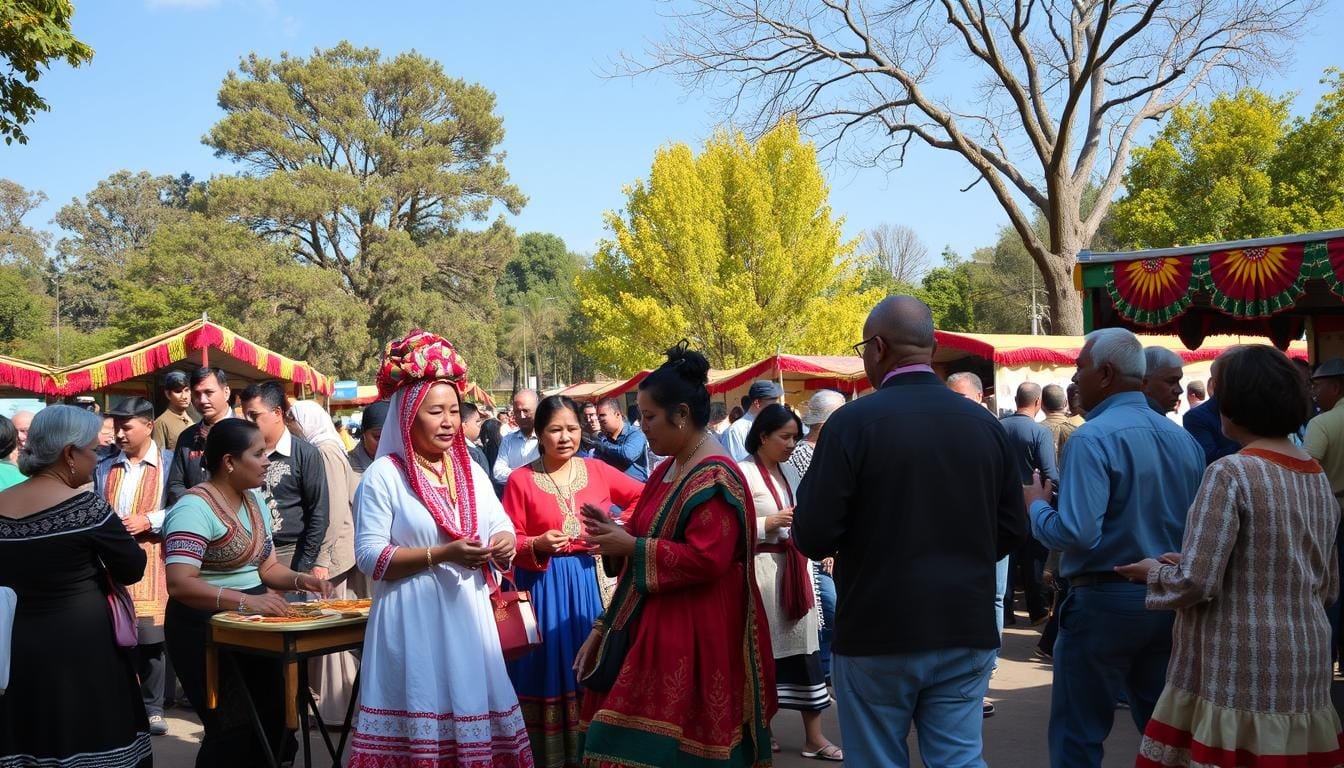How do immigrant communities keep their culture while fitting into a new society? This puzzles many as it shows the complex impact of immigrants on American culture. Cultural heritage includes tangible things, like buildings, and intangible elements, like stories and practices.
Immigrants in the United States face challenges. Yet, they manage to keep their traditions alive while adding to American culture. The link between immigrant cultural practices and cultural growth is deep. It shows how we can preserve and innovate at the same time.
From 1880 to 1924 and after 1965, over 50 million immigrants came to the United States. During the early 1900s, nearly 1 million people arrived each year. This was more than 1% of the whole U.S. population then. Despite this big change, many kept their unique customs and traditions, making their new home richer culturally.
Sharing intangible cultural heritage, like arts and social practices, is vital. It’s also important to protect these traditions for the future. Immigrants like Al Jolson and Antonin Dvorak brought fresh views to American music. These views led to big contributions.
Key Takeaways
- Immigrant communities play a crucial role in the preservation of cultural heritage, both tangible and intangible.
- Celebrations and festivals, like the Lunar New Year, are key to maintaining cultural identity.
- Teaching native languages to younger generations helps sustain traditions in diaspora.
- Balancing assimilation with cultural preservation enriches the host society as well.
- Innovative approaches, including digital storage, aid in the global sharing of cultural heritage.
Introduction: The Importance of Cultural Preservation Among Immigrants
The importance of keeping cultural traditions among immigrants is more relevant today due to globalization and migration. Studies show that documenting cultural identity has been a focus for years. For example, looking at five million census records from 1920 and 1940, and ten million birth certificates from California between 1989 and 2015, shows the effort to keep heritage alive.
Immigrants often face the challenge of keeping their traditions while adapting to new cultures. Those from cultures very different from their new home tend to adapt quicker. This is seen in how they name their children, with many choosing names that blend in more with their new country.
Research into education and work outcomes shows the problems immigrants encounter. Those with foreign-sounding names often had less education and more job issues. Their struggle to keep their cultural identity impacts their life in their new country in significant ways.
The Age of Mass Migration was a key time for immigrant adaptation. During this period, immigrants started to close the gap in naming conventions with locals. This change happened no matter the immigrant’s literacy level, showing a common desire to fit in.
The push for keeping cultural heritage alive is also seen in diverse projects over the years. The National Historic Preservation Act of 1966 and civil rights movements helped increase these efforts. Projects like Weeksville and Ybor City highlight America’s cultural diversity, celebrating its rich heritage.
Maintaining Traditional Celebrations and Festivals
Cultural heritage is key to traditional celebrations and festivals. These events help keep cultural identity alive for immigrants. They celebrate these holidays to remember who they are. The events act as a bridge, connecting them to their roots and helping them belong in new places.
The Role of Festivities in Cultural Retention
Festivals are important for keeping culture alive. They share traditional songs, dances, and foods. Cultural groups and social clubs often hold these events during major holidays. This builds community support.
In cities with many immigrants, places like cultural centers host these events. This encourages community involvement. Immigrant traditions sometimes change to fit new places, like using local foods for recipes. Celebrations like Diwali now include people from other communities. This helps everyone get along better.
Example: Celebrating Lunar New Year in the U.S.
The Lunar New Year is celebrated widely by immigrant communities in the U.S. It features family gatherings, special meals, lion dances, and fireworks. Newer immigrant groups use community centers to celebrate. This helps immigrants who are new and need support.
Many immigrants also use technology to stay connected during these times. Social media and video calls help share the festival spirit, even from far away.

Joining local community events helps with understanding different cultures. Immigrant holidays boost the economy by attracting tourists and helping local shops. This was seen with early immigrants in Minnesota, like Norwegians and Mexicans. They brought their unique holidays, adding culture to the area.
About 69% of immigrants now connect with their families online during festivals. This shows how they mix tradition with new technology. It helps keep their precious customs alive in new places.
The Role of Language in Preserving Culture
Language holds our cultural heritage, acting as a key way to share our values and traditions. The task of language preservation is key in keeping cultural identities alive. This is especially true in a world where many languages are disappearing fast.

Language as a Conduit for Cultural Practices
Language does more than let us talk to each other; it carries our cultural practices. It’s vital in sharing our traditions, rituals, and values. Research supports the idea that language shapes how we understand our culture.
Thus, losing languages quickly is not just about language. It’s about losing culture. Unfortunately, nearly 40% of languages worldwide are in danger. This puts cultural identities at serious risk.
Teaching Native Languages to Younger Generations
Teaching native languages is crucial to fight against language extinction. It also promotes bilingual education. Making bilingual education a focus helps keep cultural practices alive and strengthens community identity.
Historical data shows more U.S. residents are speaking languages other than English at home. From 11% in 1980 to 20.3% in 2010. This increase shows how important language education is for keeping cultures alive.
The Challenge of Mother Tongue Maintenance
Keeping one’s mother tongue is tough, especially for immigrant communities. Studies show over half of people from these communities deal with language shifts. This can weaken their cultural identity.
The 1910 census showed the U.S. had a lot of linguistic diversity. Many spoke languages like German, Italian, and Yiddish. Thankfully, studies now show a 35% rise in cultural pride among groups working on language preservation. This effort is key in keeping our world diverse and rich in culture.
How did immigrants preserve their culture short summary
Immigrants held onto their cultures through careful measures and changes. They kept their traditions alive, supported by strong community networks and inventive adaptations.
Transmission of Values and Beliefs
Passing down traditions is key for sharing values and beliefs between generations. Families play a major role here, teaching rituals, ethics, and traditions. The Pew Research Center found almost half of U.S. immigrants aren’t fluent in English. This fact highlights the importance of native languages in keeping cultures alive at home.
Through their mother tongues, families share important tales, customs, and moral lessons.
Creating Cultural Communities and Social Networks
Building social networks is vital for cultural preservation and change. These networks arise in places like churches, community centers, and clubs. They give a sense of belonging and help maintain cultural practices.
In the U.S., over 5.2 million children live with at least one undocumented immigrant parent. This shows the strong networks supporting cultural continuity. Such networks also help immigrants adjust and thrive in new settings.
Modern Adaptations and Innovations in Cultural Practices
In today’s world, adapting cultural practices is essential. Immigrants find creative ways to keep their traditions meaningful yet modern. Take, for example, how Asian Americans celebrate Lunar New Year in the U.S. They mix traditional elements with American ways.
This blending ensures cultures stay vibrant and relevant, fostering easier assimilation into the larger community.
Balancing Assimilation with Tradition
Many immigrants navigate assimilation and preserving traditions. This journey is complex, driven by various reasons. About 19% seek to blend in, wanting a sense of belonging.

Assimilation can weigh heavily on one’s mind. Feelings of homesickness and loss of identity are common. Facing these emotional challenges is key while trying to fit into a new society.
In the Age of Mass Migration, nearly 30 million Europeans moved to the U.S. They made up about 15% of the population in the early 20th century. Despite learning English and integrating, many still preserved their heritage.
Younger generations often adapt to American culture faster than their elders. This creates a dynamic shift within families. It highlights how cultural traditions and communication can create divides.
Acculturation combines adopting new cultural aspects and keeping original traditions. This approach helps immigrants enjoy their heritage and the new opportunities. It’s a balance between two worlds.
Maintaining language is essential for cultural ties. Losing native languages can weaken these bonds. Teaching these languages to youth is a way to preserve identity and continuity.
| Key Metrics | Statistics |
|---|---|
| Integration with Majority Culture | 19% of Voluntary Immigrants |
| Historical U.S. Immigrant Population (Early 20th Century) | 15% |
| Language Proficiency by 1930 | Most Immigrants Spoke Some English |
| Children Marrying Outside Cultural Group (Second Generation) | Over Half |
| Younger Immigrants’ Readiness to Embrace American Culture | Higher Compared to Elders |
Conclusion
In our journey, we’ve looked at how immigrants keep their culture alive. We saw the importance of festivals, keeping their language, and staying connected with their communities. These activities help keep their cultural traditions strong. Together, they create a beautiful mix that immigrants keep weaving through generations.
Immigrants work hard to fit into new countries while holding onto their unique cultures. This balance is key to building a world that values everyone’s background. Our findings highlight the need to support immigrants in keeping their cultures alive. Everyone benefits from understanding and valuing these efforts.
Migration trends, both old and new, shape these cultural stories. The UK’s diverse population and the global movement of people make the situation complex but fascinating. It’s vital to keep traditions alive as things change. This enriches all of us and ensures our communities remain diverse and full of life.
FAQ
What are some examples of how immigrants sustain their cultural heritage?
Immigrants keep their culture alive in many ways. They celebrate traditional festivals and teach their kids their native languages. They also build social networks in their communities.
Why is cultural identity important for immigrants?
For immigrants, cultural identity is key. It gives them a sense of belonging and continuity. This helps them adjust while keeping their unique heritage and traditions.
How do immigrants celebrate traditional festivals in the diaspora?
Immigrants celebrate traditional festivals by holding community events and joining parades. They cook traditional foods and take part in cultural rituals. An example is celebrating Lunar New Year in the U.S.
What role does language play in cultural preservation?
Language is a bridge for cultural practices. It lets immigrants share traditions, stories, and values with the next generation. Teaching native languages keeps their cultural heritage vibrant among the young.
What challenges do immigrants face in maintaining their mother tongue?
Immigrants find it hard to keep their mother tongue. They often have limited access to language education and feel pressure to fit in. They also struggle with using their native language and the dominant language of their new home.
How do immigrants transmit their values and beliefs to future generations?
Immigrants pass on their values and beliefs in many ways. They use family traditions, storytelling, and community involvement. They also weave their cultural practices into daily life.
How do cultural communities and social networks help in preserving culture?
Cultural communities and social networks are big supports. They share resources and offer spaces for immigrants to celebrate their heritage. They also provide mutual support.
What are some modern adaptations and innovations in cultural practices by immigrants?
Immigrants innovate and adapt their cultural practices in new settings. They use digital media to stay connected with family far away. They also update traditional attire for modern life.
How do immigrants balance assimilation with maintaining their cultural traditions?
Immigrants balance assimilation by keeping their traditions while embracing the new culture. They take part in mainstream society and adjust their cultural practices to fit in. Family and community cultural activities remain a priority.
